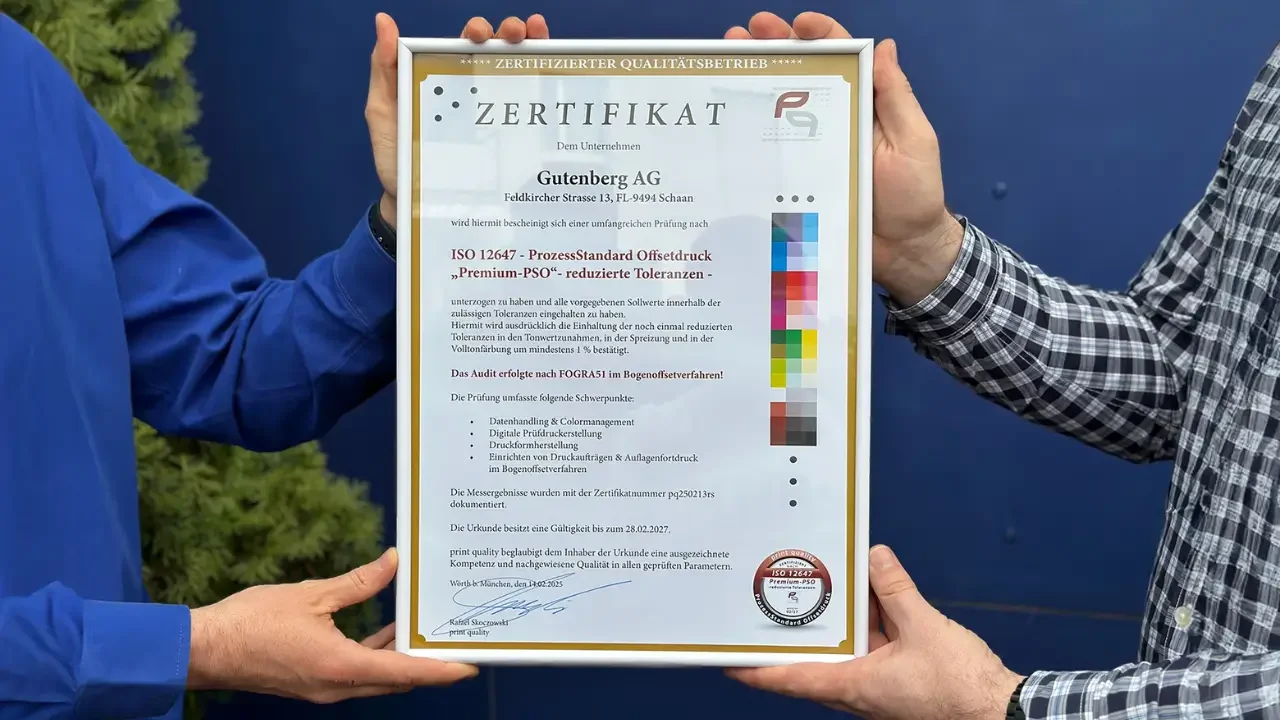We are pleased to announce that Gutenberg AG has successfully passed the comprehensive examination by Print Quality according to ISO 12647 – Process Standard Offset Printing "Premium-PSO" and is now Premium-PSO certified. This makes us the only printing company in Liechtenstein to meet this high standard. This certification is a significant step for us, as it underscores our commitment to the highest print quality and color accuracy.
Meaning of "PSO" and Differences from Premium Certification
PSO stands for "Process Standard Offset Printing." It is a standard in the printing industry that helps ensure the quality and consistency of printed products in offset printing. The PSO standard defines specific requirements for the printing process, such as color management, consistent plate imaging, correct measurement techniques, optimal settings of printing machines, and regular monitoring of the printing process.
The main difference between Premium-PSO certification and the conventional PSO package lies in the depth of examination and additional requirements. For example, color accuracy is monitored more strictly, resulting in a narrower tolerance range.
Characteristic Printing Curves as Key to Color Precision
The finished printed product does not always match the original exactly in color, as tonal values can change before the final print. But why is this the case? In offset printing, images are not made up of solid areas but rather tiny dots whose sizes vary. During the printing process, these dots expand, a phenomenon known as dot gain. Other common terms for this are dot increase or print gain. This dot gain results in a more vibrant print image than what was originally intended.
This is where the Characteristic Printing Curve comes into play. It acts as a "fingerprint" of the printing machine and indicates how much dot gain occurs so that corrections can be made if values fall outside tolerance limits. The characteristic is derived from measured dot gains determined through measurements on printed sheets. This allows for precise analysis and optimization of changes in individual colors – Cyan, Magenta, Yellow, and Black (CMYK).
Why is it necessary to determine the dot gain of a printing machine? Since a printing machine is subject to mechanical, physical, and organic influences, it always prints slightly fuller than intended in the original. Without correction, this would lead to undesirable color deviations. Therefore, determining tonal value curves is crucial to ensure that the printed result closely matches the original.
Information: What Influences Dot Gain?
The extent of dot gain depends on several factors, including the absorbency of the paper. Depending on the type of paper, ink may either penetrate slightly into the surface or spread out, leading to larger dots and thus greater dot gain.
The screen ruling is also relevant; it indicates how much percentage of an area is covered with ink – the higher the value, the more intense the color appears. A low screen ruling means few small dots, while a high screen ruling means large dots that blend together. For dot gain this means:
- Low screen ruling (below 15%): Dots are small and carry so little ink that they expand only slightly: low dot gain
- Medium screen ruling (15% to 85%): Dots carry enough ink and expand more significantly: high dot gain
- High screen ruling (above 85%): Dots overlap so much that they do not have enough space to expand: low dot gain
Color Standards According to ISO 12647 for Offset Printing
Tolerances and color spaces are defined by color standards. As part of its Premium-PSO certification, Gutenberg AG has successfully integrated FOGRA51 and FOGRA52 color standards into its printing process. These are based on ISO 12647 Process Standard and ensure precise and consistent color reproduction. These color standards were developed by FOGRA (Research Institute for Print e.V.), an international institute that develops norms and testing procedures to optimize color accuracy and reproducibility in printing.
While FOGRA51 defines the color space for offset printing on coated paper— a surface that exhibits lower dot gain due to reduced ink absorption— FOGRA52 is specifically designed for uncoated paper, also known as natural paper, which has an uncoated surface and strong optical brighteners. For warm white uncoated paper, the FOGRA47 standard is still recommended.
Tighter Color Tolerances with Premium-PSO Certification
Compared to conventional PSO certification, the tolerance limits defined by FOGRA for Premium-PSO certification are significantly tighter, allowing for even more precise and color-consistent print results. If tonal value increases of individual colors do not fall within these tolerance limits, adjustments must be made to the printing process.
fig.: Characteristic Printing Curves of the respective color
By implementing these standards, Gutenberg AG ensures precise, reproducible, high-quality print results. Whether brochures, flyers or magazines – we guarantee brilliant colors and top quality! Contact us today for advice!
fig.: At the 1st Premium PSO certificate presentation from left to right: Vivian Bolter, Claudio Pfiffner, Gilbert Schneider (printing hall), Pascal Eichmann (project manager), Rafael Skoczowski (print quality), Isani Porcic (production manager) & Hubert Biedermann (management)
Follow us on:
Contact us:
il.grebnetugobfsctd-7b6dd4@eciffo
+423 239 50 50



